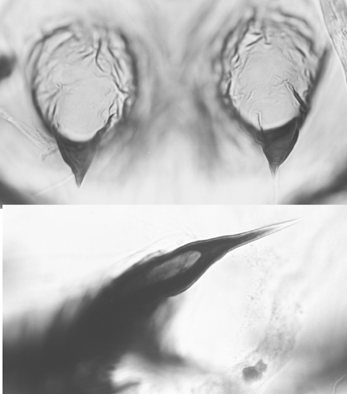"C. orientalis" immaturesLarva: a medium sized plumosus-type larva (length about 10.7 - 14.3 mm., lab. reared). Anterior ventral tubules (1.24 - 1.84 mm.) shorter than posterior pair (1.40 - 2.28 mm.).
Gula pale or very slightly darkened on posterior third; frontoclypeus slightly dark to dark.
Mentum (Fig. d) with square sharp teeth, c2 teeth of central trifid tooth well separated from c1 tooth (type III), 4th laterals slightly reduced (type I).
Ventromental plates (Fig. e) separated by about a third of the width of the mentum, with about 29-34 striae.
Pecten epipharyngis (Fig. a) with about 16-21 variable but sharp teeth. Premandible (Fig. b) with teeth about equal, or perhaps outer tooth slightly longer, inner tooth about 2-2.4 times wider than the outer.
Antenna (Fig. c) with a moderately long basal segment, which is about 4-4.5 times as long as wide; AR about 1.75-1.96. Antennal proportions: 122 : 31 : 10 : 13 : 6.
Distance between the antennal bases about equal to the distance between the S4 setae.
Mandible (Fig. f) with third inner tooth only slightly darkened (Type I), and with about 12 - 14 striae at the base. Cytology: 4 polytene chromosomes with the pseudothummi arm combination AE, BF, CD, G.
Nucleolus virtually terminal in arm G; well developed Balbiani ring (BR) about one third from the other end, and a smaller BR close to this other end; closely paired. No nucleolus in long chromosomes.
Irradiation experiments indicated only that the MD region was not on the CD chromosome.
"orl"A1: 1 - 2c, 10 - 12, 3 - 2d, 9 - 4, 13 - 19 as holomelas
"orl"B1: Puff of group 7 near middle of the arm with dark bands distal of it.
"orl"C1: Characteristic groups 3-4 about one third from distal end of the arm.
"orl"D1:
"orl"E1: 1 - 3e, 10b - 3f, 10c - 13 as halophilis, etc.
"orl"F1: (possibly) 1 - 2a, 10a-d, 15 - 14e, 9 - 2b, 11 - 14d, 16 - 23 from flaviplumus by In14d-9.
"orl"G1: Subterminal nucleolus, median and distal BRs. Chromosome arms A, E and F of a "C. samoensis" were described by Wülker et al. (1989) based on Japanese specimens, but are probably C. flaviplumus. The sequences of arms A and F of Australian specimens are not the same, although closely related to the Japanese material. The major differences are the absence of a nucleolus in arm F, arm A differing by a complex inversion, and arm F possibly by a simple inversion.
There are features of the polytene chromosome banding pattern that indicate relationship to other members of the C. samoensis complex (Martin 2011b). However it differs from C. samoensis by the nucleolar content and position, lacking nucleoli on the long chromosomes and having a terminal nucleolus in arm G.
Similarly there are differences to the members of this group from India. Pupa: Exuvia length about 7.2 - 7.8 mm; inner margin of wing case 1.42-1.45 mm. Cephalic tubercles (see below) variable, length from 23-121 µm, with subterminal setae about 60 µm long.
About 51-68 recurved hooks on abdominal segment II. Caudolateral spur (see below) of segment VIII with 1, 2 or sometimes 3 spines. Anal fringe with about 74-100 taeniae in multiple rows. 
Pupa of C. flaviplumus.Ty.3
Cephalic tubules (above) and spur, with a single spine (below).[ Return to Index | Go to C. flaviplumus type 3 adult ] |
